They say that lightning doesn’t strike twice but I’m beginning to wonder.
- The first part of today’s post will be mostly review for regular followers of Feathered Photography. Apologies for that but I felt it was necessary.
- The last four photos in today’s post, the ones taken yesterday, are soft to varying degrees. I cringe on those rare occasions when I post soft shots but in my view the documentation of this behavior deserves to be seen, soft photos or not.
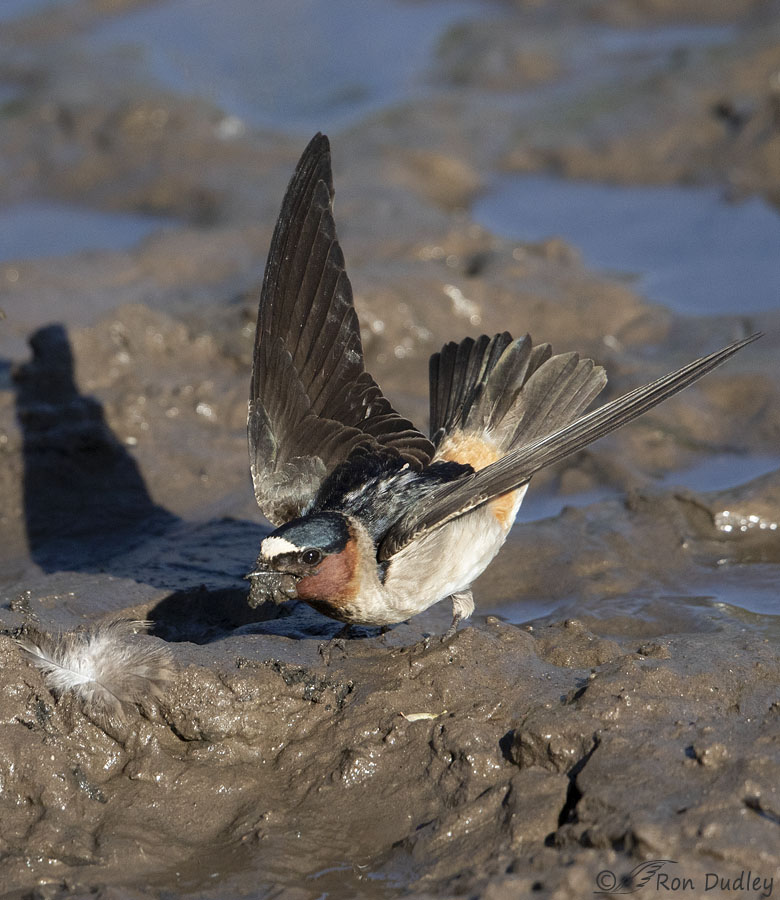
In the last twelve years or so I’ve taken many thousands of photos of Cliff Swallows collecting mud for their nests. In the past it’s always been mud, pure unadulterated mud just like we see here.
The thickness and the color of the mud may vary a little but its composition, varying amounts of clay, sand and silt, appears to be fairly consistent. Cliff Swallows are actually thought to assess the composition of the mud they collect for their nests – if given a choice they’ll choose the mud type that adheres best to their nest. They’re picky about their mud.
Barn Swallows are known to mix grass/vegetation with mud when building their nests but Cliff Swallows are not. Cornell’s Birds of the World says this on the subject of Cliff Swallow nest building material – “grass is not mixed into mud, as in Barn Swallow nests.” Dan Gleason, a regular contributor to Feathered Photography who taught ornithology at the university level for decades says that he’s “never seen” Cliff Swallows using vegetation for constructing their mud nests.
It’s true that Cliff Swallows use dry grass to line the interior of their nest after it has been built and has dried out but they’re not known to use it to actually construct their mud nest.
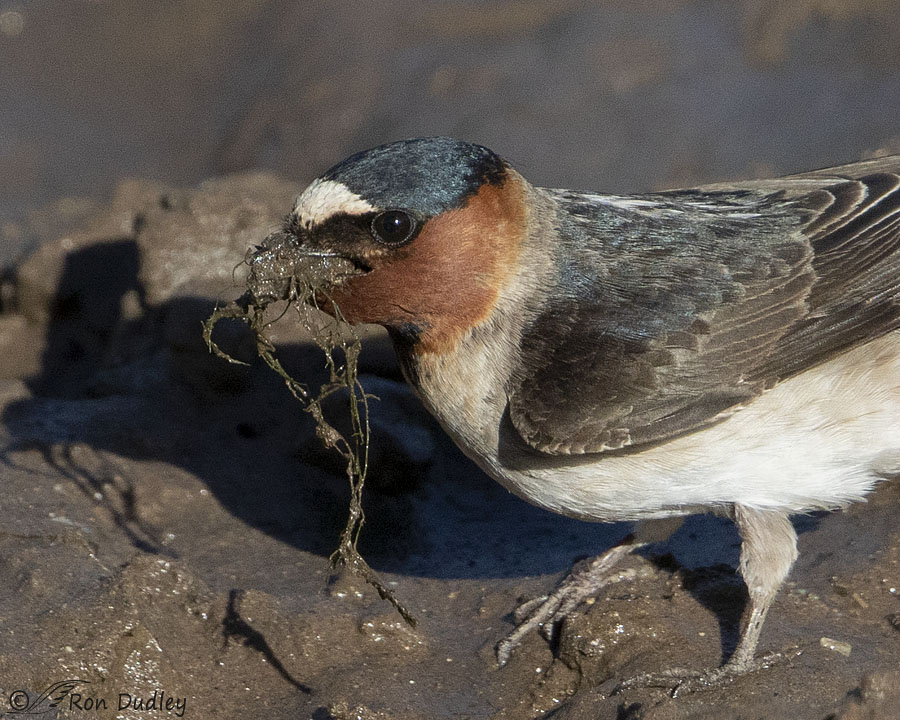
But a week ago today along a mountain streambank I photographed this Cliff Swallow gathering vegetation instead of mud for its nest.
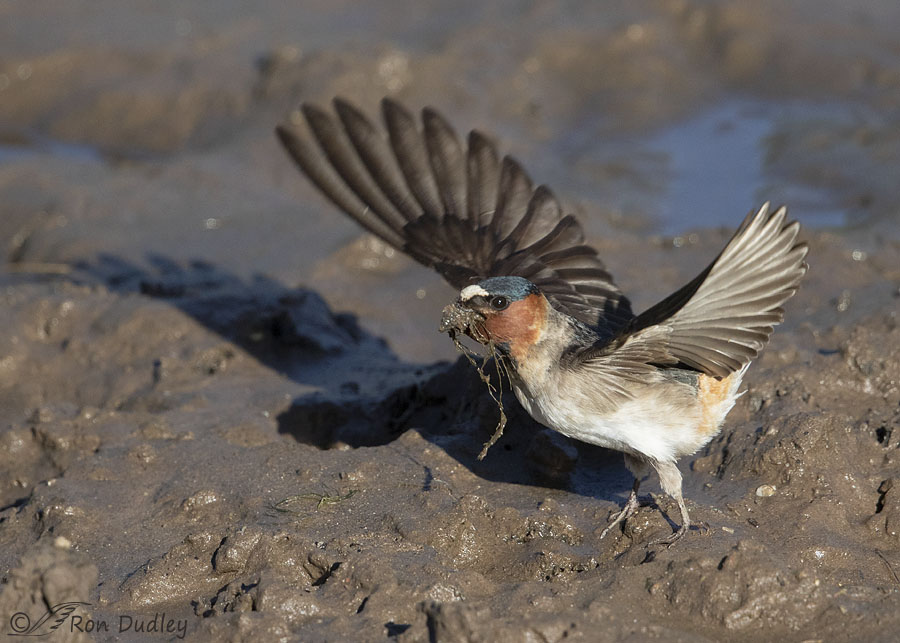
It’s not like ‘she’ picked it up by mistake – there was too much of it and she actually flew off with it to the nest she was building. I was flabbergasted so a few days ago I posted the photos above and described what I witnessed. No one else who commented on that post had ever seen the behavior either.
I thought it was a once in a lifetime event – something I’d never see again. I was wrong.

Yesterday morning Cliff Swallows were still gathering mud at the same spot along the creek bank. As usual all of the other swallows were gathering mud but this one picked up what appeared to be algae that had been growing off the driftwood when the water had been higher.
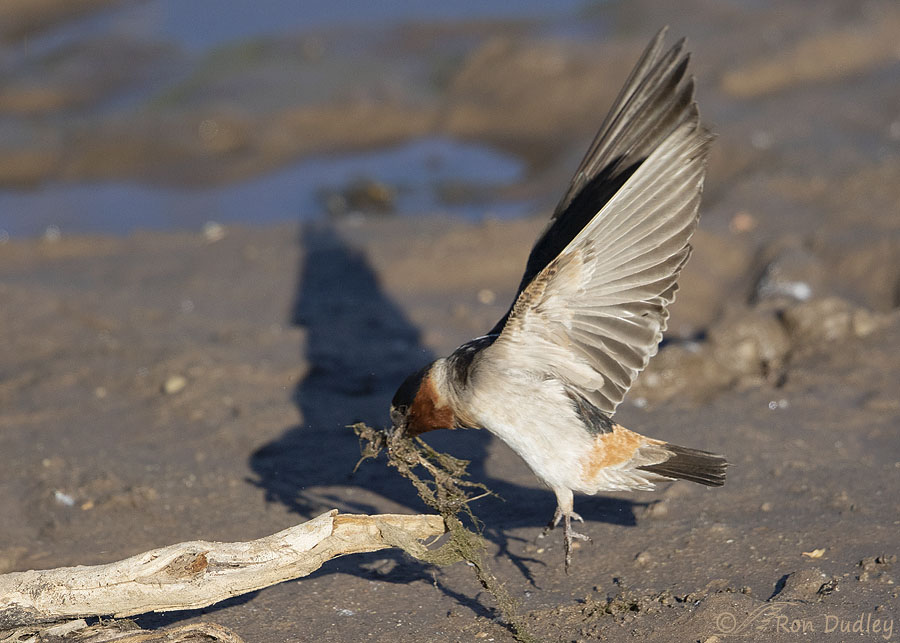
‘She’ lifted off with the obvious intention of delivering the muddy mass of algae to her nest under construction but she hit a snag. She didn’t realize that the algae/vegetation was still attached to the driftwood so…
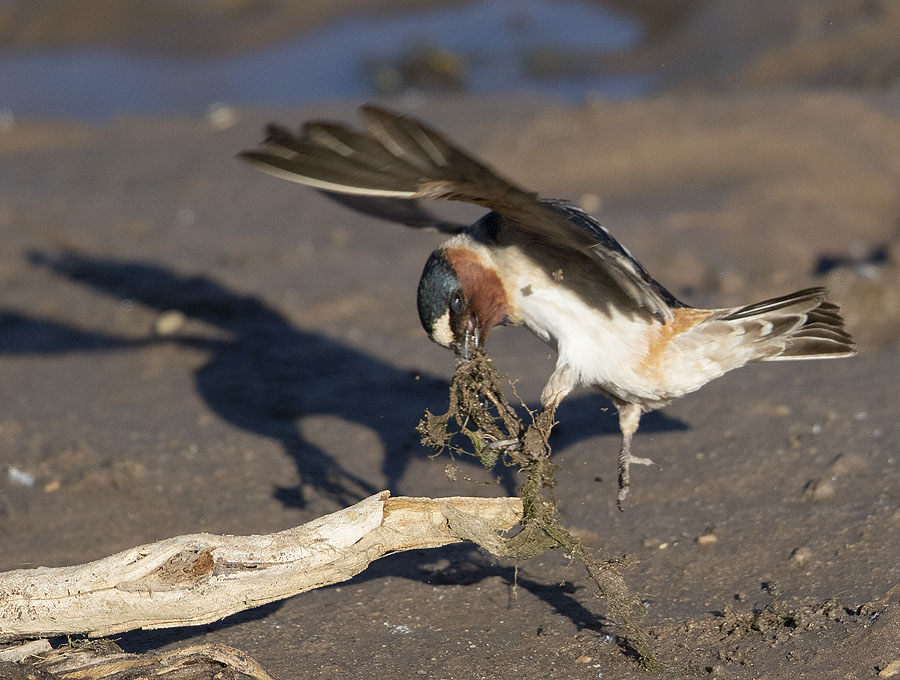
her head was violently snapped back when she reached the end of her tether.
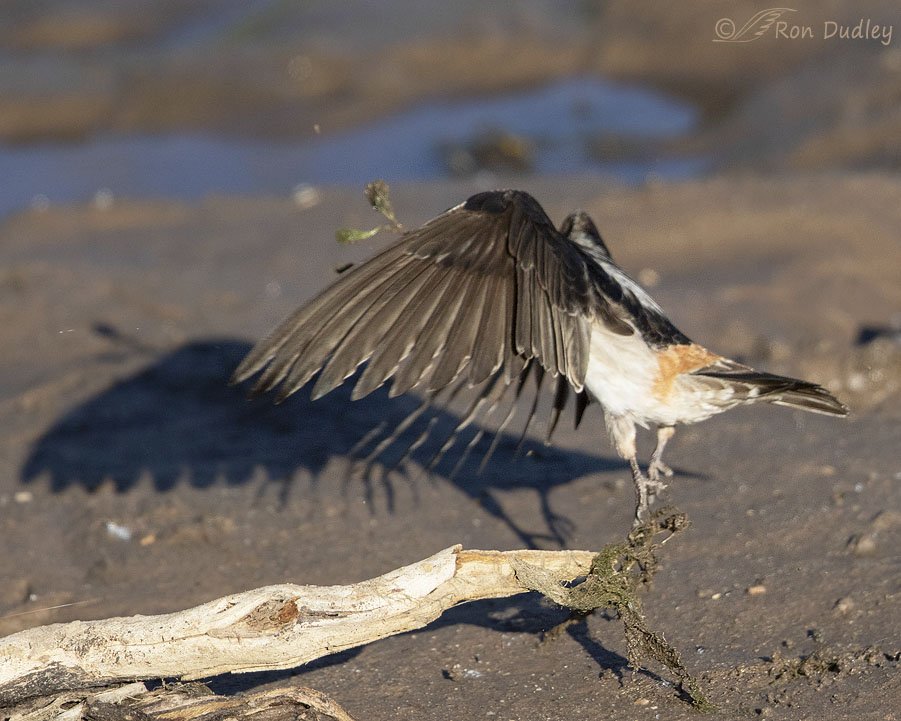
But the algae broke under the tension so she was able to to retain a small portion of it as she flew off to her nest.
I have no idea why I’d witness such an unusual (unheard of?) behavior twice within a week at the same spot along the same stream. Some thoughts that go through my mind include the following possibilities:
- the behavior isn’t as unusual as the scientific literature and others suggest
- could it have been the same swallow both times and it’s just a quirky bird for some reason?
- like physical traits many behaviors are genetically controlled (instincts) and like all genetically controlled traits they have variations. Variation is the fuel of evolution so perhaps this unusual behavior simply represents one of the extremes on the bell curve of nest building behavior.
I dunno, but at this point I’m thinking that I should at least attempt to report this behavior to an authority on Cliff Swallows as Dan Gleason suggested when I published my first post on the subject. I know from experience that that process can be endlessly frustrating but perhaps in this case it needs to be done.
Ron


In Arthur Cleveland Bent’s “Life histories of North American flycatchers, larks, swallows, and their allies” (1942) he writes:
“The cliff swallow may strengthen the walls of its plastic home by the use of straws and horsehair, but, such materials are not so freely used as they are in the nest of the the barn swallow….”
He said it, you photographed it (vegetation of some sort, anyway). Quod erat demonstrandum, as far as I’m concerned.
Interesting, Lyle.
Perhaps they’re somewhat known to use fibers in general.
Maybe in the fall an ornithologist should go to the area a pull apart some of the nests and look at what they are made of?
Makes sense to me.
I’ll ditto the other comments and add that I hope her neck is OK. (Do birds get whiplash? Is there a lawyer bird around to give her a business card?)
And to my eye, I don’t think the softness of the last shot takes away from its “interesting factor” at all! 🙂
Thanks, Marty. The last two especially are quite soft but I think they still help significantly in documenting the behavior.
I love the thought of a ‘quirky bird’. An innovator no less. I wonder how long it will take before the behaviour spreads (if the innovation is accepted).
And yes, difficult and frustrating as it is I think you do need to report this one.
“I love the thought of a ‘quirky bird’”
As do I, EC. A kindred spirit for both of us…
Yup. Quirky sounds so much nicer than eccentric (or bat-shit crazy)…
Perhaps this particular cliff swallow went to exterior decorating school and wants to one-up its peers. Not being knowledgeable about the birds or their nest-building habits (other than from seeing your photos & commentary), I wouldn’t have thought this to be odd, but it suits me fine that you’ve discovered something quite unusual. And I love all these photos, such a gorgeous creature, mouth full of mud/grass/algae or not!
Gorgeous creatures indeed, Chris. Cliff Swallows have always been a favorite of mine.
I doubt that this is a behavior that has just been missed. I think it is something new. Dr. Charles Brown has studied Cliff Swallows for more than 30 years and does not report seeing this in his account for Birds of the World. I wonder if this is the same bird and will this behavior spread to others in the population. In the 1950s Japanese researchers fed sweet potatoes to a group of macaques they were studying on an island. One female discovered that washing the potato removed the sand (or improved the taste from salt in the water). This behavior was observed by others who imitated this and it quickly spread to others in the population. Maybe the same thing is happening here. It would be interesting to see if you find more than one swallow doing this and if it only occurs at this location. (I should say that potato washing in these monkeys did spread to other islands, but not spontaneously by what has become known as the “100th monkey effect”. This idea has been debunked. The behavior spread by monkeys swimming between islands.) Let us know what you find out. It’s always exciting to find something new.
I was very much hoping you’d weigh in on this again, Dan. Thank you.
I’ll at least make the attempt to report it to Dr. Brown.
I agree, you need to report this! It is people like you that add insight to bird behavior. We all know as educators that multiple observations help to form the whole story about an organism. Great post and images!!
Thank you, Dick.
I hope you do report it and find out the truth about this renegade Cliff Swallow!
I plan on giving it a shot, Joanne.
Interesting and very perceptive of you. Maybe this will go down in history as the day when Cliff Swallows discovered “rebar.”
Okay. That made giggle!
“Maybe this will go down in history as the day when Cliff Swallows discovered “rebar.””
Then maybe swallow skyscrapers are next…
We live in South Carolina and some type of bird built a nest of mud and grass under our deck—stuck it to the wood with mud and lots of grass. Four babies are there, but I don’t know what kind.
Shouldn’t be too hard to find out with a bird field guide, Gail.
Absolutely report it! What’s the worst that could happen? After all, it’s not like you haven’t been ignored before 😉
Personally, I think it’s quite possible that a) the cliff swallows either figured out on their own or learned from a barn swallow traveling through, thinking, “huh, that would make my nest stronger and that’s a good thing,” OR b) that the various -ologists either didn’t see it when it was happening OR c) they didn’t write it down because they’d filled their notebooks and forgot when they sat down to write their book. But no matter what happened, you have the opportunity to rewrite the natural history! YAY YOU! 😉
Zoe woke me early this morning, and now that I have all my chores done, I can let my mind wander a bit.
“Absolutely report it!”
I hope to later today, Laura.
Excellent photography Ron. It will be interesting to see if one of your followers or perhaps someone you contact who is an expert in the field can elaborate on this behavior. It would seem to me that the addition of algae or most any vegetation would strengthen the mud building process. Perhaps this is the same bird and he is the Alexander Graham Bell of his species. A natural born inquisitive inventive Swallow.
Thanks, Everett. I think of this bird as Mr. (or Miss) Edison… 🙂
I agree about reporting this …it is definitely food for thought. Perhaps a third trip is warranted soon; not sure how long the construction process continues but does seem like it is not a ‘one-time- occurrence.
Kathy, I’m in that area often so I’ll probably be there again in the next few days.
Obviously wasn’t a “one off” that the swallow wasn’t using “pure mud”….. 🙂 Always interesting what “mother nature” comes up with. Are there ever “mixed flocks” of swallows allowing one to “learn” from the other even if it’s mostly “hard coded?” Definitely needs to be reported even if a screaming headache to do so…. 😉
Hoping for a calmer day “critter wise” here today!
Judy, yes, I’ve seen the occasional Barn Swallow collecting mud mixed in with Cliff Swallows doing the same thing.
Good Early Morning from the East, Remarkable photos…I like the shadows.I This series would be a fine children’s book! Seems like the grass algae would be a good nesting material. Thanks, Ron!
Early morning indeed. It’s crazy how early I got up this morning. Thanks, Mary.